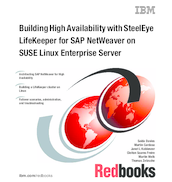Abstract
Business processes based on the SAP® NetWeaver® platform often require a high level of availability and fault tolerance.
Availability can be defined as the amount of time that application services are accessible to the end user, and is measured by the percentage of time that the application is available to the user. The application is highly available when it gets closer to the difficult-to-achieve 99.999% threshold of availability, also known as the five 9s of availability.
The Novell® SUSE® Linux® Enterprise Server base operating system, SteelEye® LifeKeeper® for Linux cluster software, and SAP NetWeaver software provide capabilities that can be implemented to build a topology that fulfills these requirements.
In this IBM® Redbooks® publication, we discuss the concepts of high availability, provide an overview about the main components, and explain high availability topologies and implementation.
We cover these topics: Server hardware configuration, Novell SUSE Linux Enterprise Server software installation, SteelEye LifeKeeper cluster software installation, Network topology and configuration, Storage topology and configuration, DB2® software installation, and SAP NetWeaver software installation.
We also discuss the integration, test, and operation of all these components.
Table of Contents
Chapter 1. High availability overview
Chapter 2. Introduction to SAP NetWeaver, Novell SUSE Linux Enterprise Server, and SteelEye LifeKeeper
Chapter 3. High availability architectural considerations
Chapter 4. High availability topologies
Chapter 5. High availability implementation
Chapter 6. Testing and failover scenarios
Chapter 7. Administering the cluster
Chapter 8. Troubleshooting
Appendix A. Additional material
Related product families
Product families related to this document are the following:

